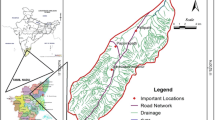Abstract
Hydrologic modelling is pre-requisite to water resources management. Unfortunately, hydrologic modelling in data scare basin has always been difficult. The current study, explored the use of “data limited” model Soil Water Assessment Tool (SWAT) in modelling lower Aswa basin located in northern Uganda. The study adopted different techniques in generating and estimating various missing model parameters and input especially solar radiation, saturated soil hydraulic conductivity, available soil water content, Universal Soil Lost Equation erodibility factor and moist soil albedo. Soil Water Assessment Tool model was then manually calibrated using monthly historical streamflow records. The calibration was successful with coefficient of determination (R2) value of 0.618 and the Nash and Sutcliffe efficiency value of 0.47. Validation of the calibrated model using independent dataset shows even better model performance with Nash and Sutcliffe efficiency value of 0.64 and coefficient of determination (R2) value of 0.56. Successful calibration of hydrologic model Soil Water Assessment Tool under the data scarcity still proves the potential of the application of the model even in data limited basin, but more especially by water resources managers who needs understanding of existing condition and modelling possible future.






Similar content being viewed by others
References
Abbott MB, Bathurst JC, Cunge JA, O’Connell PE, Rasmussen J (1986a) An introduction to the European hycirological system-systeme hydrologique European ‘SHE’ 1: history and philosophy of a physically-based, distributed modeling system. J Hydrol 87:45–59
Abbott MB, Bathurst JC, Cunge JA, O’Connell PE, Rasmussen J (1986b) An introduction to the European hydrological system-systeme hydrologique Europeen, ‘SHE’ 2: structure of physically-based, distributed modeling system. J Hydrol 87:61–77
Ahuja LR, Brakensiek DL, Shirmohammadi A (1993) Infiltration and soil movement. In D. R. Maidment (Editor), Handbook of Hydrology. McGraw-Hill, New York (U.S.A.)
Allen RG, Pereira LS, Raes D, Smith M (1998) Crop evapotranspiration - Guidelines for computing crop water requirements - FAO Irrigation and drainage paper 56. Water Resources Development and Management Service, FAO Rome
Arnold JG, Srinivasan R, Muttiah RS, Williams JR (1998) Large area hydrologic modeling and assessment. Part I. Model development. J Am Water Resour Assoc 34:73–89
Beven KJ (1995) Linking parameters across scales: sub-grid parameterisations and scale dependent hydrological models. Hydrol Process 9:507–526
Beven KJ (2001) Dalton medal lecture: how far can we go in distributed hydrological modelling? Hydrol and Earth Syst Sci 5(1):1–12
Boswell VG (1926) The influence of temperature up on the growth and yield of garden peas. Proc of Am Soc of Hortic Sci 23:162–168
D’urso G (2001) Simulation and management of on-demand irrigation systems: a combined agrohydrological and remote sensing approach. PhD Thesis, Wageningen University, Wageningen, The Nertherlands
Gassman PW, Reyes MR, Green CH, Arnold JG (2007) The soil and water assessment tool: historical development, applications, and future research directions. Trans ASABE 50(4):1211–1250. doi:10.13031/2013.23637
Hamilton S (2007) Completing the loop: from data to decisions and back to data. Hydrol Process 21(22):3105–3106
Hargreaves GH, Samani ZA (1982) Estimating potential evapotranspiration. J. Irrig. and Drain. Engr. ASCE 108(IR3):223–230
James LD, Burges SJ (1982) Selection, calibration, and testing of hydrologic models. In: Haan CT, Johnson HP, Brakensiek DL (eds) Hydrologic modeling of small watersheds. ASAE Monograph, St. Joseph, Michigan
Magoon CA, Culpepper CW (1932) Response of sweet corn to varying temperatures from time of planting to canning maturity, U.S.D. A Technical Bulletin, 312
Moriasi DN et al (2007) Model evaluation guidelines for systematic quantification of accuracy in watershed simulations, T. ASABE 50:885–900
Nash JE, Sutcliffe JV (1970) River flow forecasting through conceptual models, part I - a discussion of principles. J Hydrol 10:282–290
Santhi C, Arnold JG, Williams JR, Hauck LM, Dugas WA (2001) Application of a watershed model to evaluate management effects on point and nonpoint source pollution. Trans Am Soc Agric Eng 44(6):1559–1570
Saxton KE, Rawls W (2006) Soil water characteristic estimates by texture and organic matter for hydrologic solutions. Soil Sci Soc Am J 70:1569–1578
Sharpley AN, Williams JR (1990) Erosion/productivity impact calculator, 1. Model documentation. USDA-ARS Technical Bulletin 1768, Washington, DC
Van Griensven A (2005) Sensitivity, auto-calibration, uncertainty and model evaluation in SWAT2005. Unpublished report
Van Liew MW, Schneider JM, Garbrecht JD (2003) Stream flow response of an agricultural watershed to seasonal changes in rainfall. In: Renard KG, McElroy SA Gburek WJ, Canfield HE, Scott RL (eds) Proceedings, 1st interagency conference on research in the watershed. U.S. Department of Agriculture, Agricultural Research Service, Benson, Arizona
Williams JR (1995) The EPIC model. SWAT models, Input/Output file documentation, Version 2005
Yang J, Liu Y, Yang W, Yaning C (2012) Multi-objective sensitivity analysis of a fully distributed hydrologic model WetSpa. Water Resour Manag 26(1):109–128
Author information
Authors and Affiliations
Corresponding author
Rights and permissions
About this article
Cite this article
Nyeko, M. Hydrologic Modelling of Data Scarce Basin with SWAT Model: Capabilities and Limitations. Water Resour Manage 29, 81–94 (2015). https://doi.org/10.1007/s11269-014-0828-3
Received:
Accepted:
Published:
Issue Date:
DOI: https://doi.org/10.1007/s11269-014-0828-3




